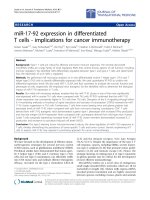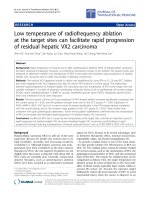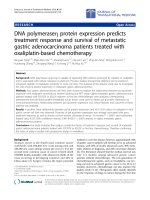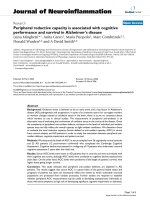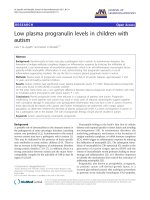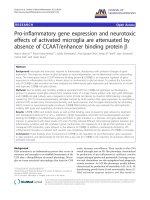báo cáo hóa học:" Low RBM3 protein expression correlates with tumour progression and poor prognosis in malignant melanoma: An analysis of 215 cases from the Malmö Diet and Cancer Study" potx
Bạn đang xem bản rút gọn của tài liệu. Xem và tải ngay bản đầy đủ của tài liệu tại đây (1011.03 KB, 9 trang )
RESEARCH Open Access
Low RBM3 protein expression correlates with
tumour progression and poor prognosis in
malignant melanoma: An analysis of 215 cases
from the Malmö Diet and Cancer Study
Liv Jonsson
1†
, Julia Bergman
1†
, Björn Nodin
1
, Jonas Manjer
2,3
, Fredrik Pontén
4
, Mathias Uhlén
5,6
and Karin Jirström
1*
Abstract
Background: We have previously reported that expression of the RNA- and DNA -binding protein RBM3 is
associated with a good prognosis in breast cancer and ovarian cancer. In this study, the prognostic value of
immunohistochemical RBM3 expression was assessed in incident cases of malignant melanoma from a prospective
population-based cohort study.
Methods: Until Dec 31
st
2008, 264 incident cases of primary invasive melanoma had been registered in the Malmö
Diet and Can cer Study. Histopathological and clinical information was obtained for available cases and tissue
microarrays (TMAs) constructed from 226 (85.6%) suitable paraffin-embedded tumours and 31 metastases. RBM3
expression was analysed by immunohistoche mistry on the TMAs and a subset of full-face sections. Chi-square and
Mann-Whitney U tests were used for comparison of RBM3 expression and relevant clinicopathological
characteristics. Kaplan Meier analysis and Cox proportional hazards modelling were used to assess the relationship
between RBM3 and recurrence free survival (RFS) and overall survival (OS).
Results: RBM3 could be a ssessed in 215/226 (95.1%) of primary tumours and all m etastases. Longitudinal analysis
revealed t hat 16/31 (51.6%) of metastases lacked RBM3 expression, in contrast to the primary tumours i n w hich RBM3 was
absent in 3/215 (1.4%) cases and strongly expressed in 120/215 (55.8%) cases. S trong nuclear RBM3 expression in t he
primary t umour was significantly associated with fa vourable clinicopathological parameters; i .e. non-ulcerated tu mours,
lower depth of invasion, lower Clark level, less a dvanced clinical stage, l ow mitotic activity a nd non-nodular histological
type, a nd a prolonged RFS (RR = 0.50; 95% CI = 0.27-0.91) and OS ( RR = 0.36, 95%CI = 0.20 -0.64). Multivariate analysis
demonstrated t hat the beneficial prognostic value of RBM3 r emaine d s ignificant for OS ( RR = 0.33; 95%CI = 0.18-0.61).
Conclusions: In line with previous in vitro data, we here show that RBM3 is down-regulated in metastatic melanoma
and high nuclear RBM3 expression in the primary tumour is an independent marker of a prolonged OS. The potential
utility of RBM3 in treatment stratification of patients with melanoma should be pursued in future studies.
Background
Malignant melanoma is an aggressive form of cancer
with a variable clinical cours e even in patients with thin
melanomas and localized disease [1-4]. Despite increas-
ing insigh ts into melanoma biology and the discovery of
gene- and protein-signatures that supplement
established prognostic clinicopathological parameters
[5-7], no biomarkers have yet been incorporated into
clinical protocols.
The RNA-binding motif protein 3, RBM3, was initially
identified in a human fetal brain tissue cDNA library
[8]. The RBM3 gene maps to Xp11.23 and encodes two
alternatively spliced RNA transcripts. RBM3 transcripts
have been found in various human tissues [8] and in
vitro, RBM3 is one of the earliest proteins synthesized
in response to cold shock [9]. RBM3 contains one RNA-
* Correspondence:
† Contributed equally
1
Department of Clinical Sciences, Pathology, Lund University, Skåne
University Hospital, 221 85 Lund, Sweden
Full list of author information is available at the end of the article
Jonsson et al. Journal of Translational Medicine 2011, 9:114
/>© 2011 Jonsson et al; licensee BioMed Central Ltd. This is an Open Access article dist ributed under the terms of the Creative Commons
Attribution License ( whi ch permits unre stricted use, distribution, and reproduction in
any medium, provided the original work is properly cited.
recognition motif (RRM) and is able to bind to both
DNA and RNA, whereby a glycine rich region adjacent
to the RNA binding motif is thought to enhance the
protein-RNA or protein-DNA interaction [8,10].
BasedonaninitialdiscoveryintheHumanProtein
Atlas (HPA) [11-13], we have
recently demonstrated that tumour-specific expression
of RBM3, in particular its nuclear localization, is asso-
ciated with a significantly improved survival in breast
cancer [14] and ovarian cancer [15], and that RBM3
confers cisplatin sensitivity in ovarian cancer cells [15].
Apart from these studies, we are not aware of any other
publications related to the prognostic or treatment pre-
dictive impact o f the tumour-specific expression of
RBM3 in human cancer, and the biological processes
underlying these observations have not yet been unra-
veled. It is evident that RBM 3 is up-regulated in various
types of human malignancies [14,16,17] and in vitro stu-
dies in a w ide range of different model systems have
demonstrated that RBM3 is involved in multiple pro-
cesses central to cancer biology, like proliferation
[15-17], apoptosis [18,19] and angiogenesis [16].
The prognostic value of RBM3 expression has, to our
knowledge , not yet been investigated in malignant mela-
noma. However, down-regulation of RBM3 at the gene
expression level has been demonstrated in an in vitro
model of melanoma progression [20].
In the present study, we investigated the prognostic
impact of immunohistochemical (IHC) RBM3 expres-
sion in 215 incident malignant melano mas in the pro-
spective, population-based cohort Malmö Diet and
Cancer Study (MDCS) [21]. For this purpose, tissue
microarrays (TMAs) were constructed from suitable
tumours (n = 226) and a subset of metastases (n = 31).
It is demonstrated that strong nuclear expression of
RBM3 correlates with favourable clinicopathological
parameters and independently predicts a significantly
prolonged overall survival. In addition, a markedly
reduced expression of RBM3 was observed in metastases
compared to primary tum ours, which is quite in line
with previous in vitro data [20].
Methods
The Malmö Diet and Cancer Study
The Malmö Diet and Cancer Study (MDCS) is a popula-
tion-based prospective cohort study with the main aim
to examine whether a Western diet rich in fat and low
in fruit and vegetables increases the risk of certain
forms of can cer. Between 1991-1996, a total number of
28 098 individuals; 11 063 (39 ,4%) men and 17 035
(60,6%) women between 44-74 years where enrol led
(from a background population of 74 138). All partici-
pants completed the baseline examination, which
included a questionnaire, measures of anthropometric/
body compositions and a dietary assessment. The ques-
tionnaire covered questions on physical activity, use of
tobacco and alcohol, heredity, socio-economic factors,
education, occupation, previous and current disease and
current medication. In addition, blood samples were col-
lected and stored in -80°C. Follow up is done annually
by record-linkage to national registries for cancer and
cause of death [22].
Ethical permissions for the MDCS (Ref. 51/90) and the
present study (Ref. 530/2008) were obtained from the
Ethical Committee at Lund University.
Incident malignant melanomas until Dec 31
st
2008
Until end of follow-up 31 December 2008, 264 incident
invasive malignant melanomas had been registered in
the stu dy populatio n. Cases were ident ified from the
Swedish Ca ncer Registry up u ntil 31 Dec 2 007, and
from The S outhern Swedish Regional Tumour Registry
for the period of 1 Jan-31 Dec 2008. All tumours with
available slides and/or paraffin blocks were histopatholo-
gically re-evaluated on haematoxylin and e osin stained
slides whereby information on lymphocytic infiltration
(none, mild, moderate or high), ulceration (absent or
present), mitotic count and vascular invasion was
obtained. Data on location, Clark l evel and Breslow
depth of invasion was obtained from the clinical- and/or
pathology records.
Information on recurrence (local, regional or distant)
was obtained in 2010 from patient records and pathol-
ogy reports . Information on vital status and cause of
death was obtained from the Swedish Cause of Death
Registry up until 31 Dec 2009.
Tissue microarray construction
Paraffin-embedded tumour specimens were collected
from the archives of the pathology departments in the
region of Skåne in Southern Sweden. Tumours with an
insufficient amount of material were excluded. Areas
representative of cancer were then marked on haema-
toxylin & eosin stained slides and TMAs constructed as
previously described [23]. In brief, three 0,6 mm cores
were taken from each tumour and mounted in a n ew
recipient block using semi-automated arraying device
(TMArrayer, Pathology Devices, Westminster, MD,
USA). In addition, metastases (representing both regio-
nal and distant metastases in various organs) were
sampled from 31 cases. Thin melanomas (< 1 mm) were
subjected to TMA construction if the diameter was > 1
cm. To check for heterogeneity, IHC stainin g was also
performed on additional full-face sections from 25 cases.
Immunohistochemistry and evaluation of RBM3 staining
For immunohistochemical analysis, 4 μm TMA-sections
were automatically pre-treated using the PT-link system
Jonsson et al. Journal of Translational Medicine 2011, 9:114
/>Page 2 of 9
(DAKO, Glostrup, Denmark) and then stained in a
Autostainer Plus (DAKO, Glostrup, Denmark) with the
mouse monoclonal anti-RBM3 antibody (AAb030038;
Atlas Antibodies AB, Stockholm, Sweden, diluted
1:5000). The specificity of the antibody has been vali-
dated previously [15].
As RBM3, when present, was expressed in > 75 % of
the cells, predominantly in the nuclei and in varying
intensities, only the intensity of the staining was
accounted for and denoted a score from 0 (negative), 1
(mild), 2 (moderate) and 3 (strong) . The staining was
evaluated by three independent observers (LJ, JB, and
BN) who were blinded to clinical and outcome data.
Scoring differences were discussed in order to reach
consensus.
Statistical analysis
Chi-square and Mann-Whitney U tests were used for
comparison of RBM3 expression and relevant clinico-
pathological characteristics. Recurrence was defined as
local, regional or distant recurrence or death from
malignant melanoma and risk of recurrent disease was
referred to as recurrence f ree survival (RFS). Follow-up
started at date of diagnosi s and ended at recurrent dis-
ease, death, lost to follow-up (emigration) or last date of
follow- up with regard to recurrent disease. No recur-
rences were recorded following the last date of follow-
up regarding death, i.e. 31 Dec 2009. Overall s urvival
(OS) was assessed by calculating the risk of death from
all causes, overall mortality. Follow-up started at date of
diagnosis and ended at death, emigration or 31 Dec
2009, whichever came first.
Kaplan-Meier analysis and log rank test were used to
illustrate differences in RFS and OS. Cox regression pro-
portional hazards models were used to estimate the
impact of the investigated parameters on RFS and OS in
both uni- and multivariate analysis. Some subjects had
no information on one or several markers and missing
values were coded as a separate category for categorical
variables and as the mean of all observations for conti n-
uous variables. Missing values for categorical variables
co-varied and the multivariate model did not converge
due to many constant values. In order to avoid this, the
multivariate analysis only included patients with infor-
mation on RBM3. In addition, the patient with missing
information on lymphocyt ic infiltration had to be
excluded. Co-variat es were enter ed into the multi variate
analysis using backward selection were a p-value of 0.05
decided entry and a p-value of 0.20 was used for
removal. RBM3 was included in all models irrespective
of the backward selection procedure.
All tests were two sided. A p-value of 0.05 was consid-
ered significant. All statistical analyses were performed
using SPSS version 17 (SPSS Inc, Chicago, IL).
REMARK criteria
A description of the fulfilment of REMARK [24] criteria
for biomarker studies is provided in Additional file 1,
Table S1.
Results
Distribution of clinicopathological parameters in the
cohort
The distribution of patient- and tumour characteristics
in the full cohort is shown in Table 1. In line with the
relatively high median age of cases (69 y ears, range 44-
85), the frequency of lentigo maligna melanomas was
slightly higher (11.7%) than the average expected around
7% in Sweden [2]. The proportion of thinner melanomas
(< = 1 mm, Stages 1A-B) was also higher than expected
(86.5% compared to ~55.1%) as well as the proportion
of non-ulcerated tumours (14.1% compared to ~24.1%)
[2].
Immunohistochemical expression of RBM3 in primary
tumours and metastases
Of the 226 cases in the TMA cohort it was possible to
evaluate the expression of RBM3 protein in 215 cases
(95,1%). The re was no obvious heterogeneity in the
staining pattern between the tissue cores. There was an
excellent concordance between RBM3 scores assessed
on full-face s ections and TMAs (kappa-value 0.85).
Examples of immunohistochemical staining are shown
in Figure 1A-D and the staining distribution in primary
tumours vs metasta ses in Figure 1E-F. Interestingly, and
in line with previous in vitro data [20], RBM3 expres-
sion was strong in the majority of primary tumours, but
weak or absent in the metastases (Figure 1E-F). Notably,
sim ilar associations were seen when compar ing primary
tumours and metastases in the 31 cases, for which both
locations had been sampled (data not shown).
Association between RBM3 expression and
clinicopathological parameters
As shown in Table 2, there was a strong association
between low RBM3 expression and depth of invasion,
Clark level, clinical stage, mitotic count, nodular vs non-
nodular t ype and ulceration. However, localization, age,
lymphocytic infiltration and melanoma type were not
associat ed with R BM3 expression. In some c ases with
strong RBM3 expression , cytoplasmic staining was pre-
sent in various intensities, but this did not add any
prognostic value (data not shown).
Impact of high RBM3 expression on recurrence free
survival and overall survival
Having demonstrated that RBM3 is associated with less
advanced disease and favourable clinicopathological
parameters, the relationship between RBM3 expression
Jonsson et al. Journal of Translational Medicine 2011, 9:114
/>Page 3 of 9
and disease outcome was e xamined. For survival analy-
sis, data were dichotomized into strong vs negative-
moderate intensity for RBM3.
Kaplan Meier analysis of the evaluated cohort (n =
215) demonstrated that high expression of RBM3 was
Table 1 Patient and tumour characteristics in the full
cohort (n = 264)
Age
Mean 67.29
Median 69.00
Range 46-84
Sex
Female 135 (51.1%)
Male 129 (48.9%)
Location
Head and neck 17 (14.9%)
Extremities 111 (44.8%)
Dorsal thorax 65 (26.2%)
Frontal thorax 35 (14.1%)
Unknown 16
Clark level
II 93 (37.7%)
III 103 (41.7%)
IV 44 (17.8%)
V 7 (2.8%)
Unknown 17
Breslow (mm)
Mean 1.57
Median 0.71
Range 0.08-40.00
Breslow AJCC categories
< = 1 158 (59.8%)
1-2 36 (13.6%)
2-4 40 (15.2%)
> 4 14 (5.3%)
Unknown 16 (6.1%)
Clinical Stage
1A 154 (74.4%)
1B 25 (12.1%)
2A 17 (8.2%)
2B 7 (3.4%)
3A 2 (1.0%)
4 2 (1.0%)
Unknown 57
Histological type
SSM 160 (64.5%)
NMM 53 (21.48%)
LMM 29 (11.7%)
Other 6 (2.4%)
Unknown 16
Ulceration
Absent 214 (85.9%)
Present 35 (14.%)
Unknown 16
Mitotic count
< 1/mm
2
131(51.8)
> = 1/mm
2
122(46.2)
Lymphocytic infiltration
None-mild 72 (29.0%)
Figure 1 RBM3 expression in primary melanomas and
metastases. Examples of malignant melanomas with (A) negative,
(B) weak, (C) intermediate and (D) strong immunohistochemical
RBM3 staining. RBM3 expression was strong in the majority of (E)
primary tumours compared to (F) metastases.
Table 1 Patient and tumour characteristics in the full
cohort (n = 264) (Continued)
Moderate-high 176 (66.7%)
Unknown 16
Recurrence
No 217 (82.2%)
Yes 47 (17.8%)
Follow-up (years)
Mean 7.25
Median 6.88
Range 0.64-17.05
Vital status
Dead 55 (20,8%)
Alive 219 (79,2%)
Dead from malignant melanoma 28 (10.6%)
Jonsson et al. Journal of Translational Medicine 2011, 9:114
/>Page 4 of 9
associated with a significantly prolonged RFS (p = 0.020)
and OS (p < 0.001) (Figure 2). In Cox multivariate ana-
lysis, high RBM3 expression remained an independent
prognostic parameter for OS but not RFS (Table 3).
In thin melanomas (< = 1 mm; n = 129) there was no
significant association between RBM3 expression and
RFS (data not shown) and a trend, however non-signifi-
cant, towards a prolonged OS for tumours with high
RBM3 expression (RR = 0.48; 95%CI = 0.18-1.24). In
melanomas > 1 mm (n = 84), RBM3 was not associat ed
with RFS (data not shown) but with a significantly
improved OS (RR = 0.40; 95% CI = 0.19-0.85), whic h
remained significa nt in multivariate analysis (RR = 0.29;
95% CI = 0.11-0.77). Notably, tumour thickness mea-
sured as a continuous variable did not remain significant
in multivariate analysis. However, this was not altered
when AJCC categories (< 1 mm, 1-2 mm, 2-4 mm and
> 4 mm) were used instead or when clinical stage was
excluded from the analysis (data not shown).
Information on tumour diameter w as only available
for 162 (61%) of the patients and therefore not includ ed
in the analyses. There was an inverse association
between tumour diameter and RBM3 expression (p =
0.030) but not to depth of invasion (data not shown).
There was no associat ion between tumour diameter and
survival (data not shown)
Discussion
This study provides a first description of the patient and
tumour characteristics of incident cases of malignant
melanoma in the prospective, population-based cohort
Malmö Diet and Cancer Study, diagnosed until Dec 31
st
,
2008. In addition, it is demonstrated that the investiga-
tive biomarker RBM3 is down-regulated in metastatic
deposits, associated with favourable histopathological
parameters in primary melanomas and an independent
predictor of a prolonged overall survival. In a transla-
tional context, these findings are quite in line with a
Table 2 Association between RBM3 expression and
clinicopathological parameters
RBM3 staining intensity
0-2 3
n(%) 95 (44.2) 120 (55.8) p-value
Age
Mean 68.00 67.15 0.673
(range) (47-83) (46-81)
Gender
Female 45(47.4) 63(52.5) 0.457
Male 50(52.6) 57(47.5)
Clark level
II 21(22.3) 50(42.4) 0.005**
IIII 48(51.1) 46(39.0)
IV-V 25(26.6) 22(18.6)
missing 1 2
Breslow(mm)
Mean 2.47 1.12 0.001**
(range) (0.08-40.00) (0.11-7.00)
Ulceration
No 71(74.7) 109(91.6) 0.001**
Yes 24(25.3) 10(8.4)
missing 0 1
Lymphocytic
infiltrate
0-1 26(27.4) 34(28.6) 0.846
2-3 69(72.6) 85(71.4)
missing 0 1
Clinical stage
I 54(76.1) 95(91.3) 0.005*
II-IV 17(23.9) 9(8.7)
missing 24 16
Vascular invasion
No 87(91.6) 114(95.0) 0.314
Yes 8(8.4) 6(5.0)
Localization
Head and neck 15(16.0) 16(14.0) 0.352
Extremities 40(42.6) 59(51.8)
Frontal thorax 10(10.6) 15(13.2)
Dorsal thorax 29(30.9) 24(21.1)
missing 1 6
Type
SSM, LMM, Other 65(58.9) 97(68.9) 0.027*
Table 2 Association between RBM3 expression and clini-
copathological parameters (Continued)
NMM 30(31.6) 22(18.5)
missing 0 1
Mitotic count
< 1/mm
2
34(35.8) 71(59.2) 0.001**
> = 1/mm
2
61(64.2) 49(40.8)
*Significant at the 0.05 level
** Significant at the 0.01 level
§ Mann Whitney U test for comparison of means
SSM = Superficial spreading melanoma
NMM = Nodular malignant melanoma
LMM = Lentigo malignant melanoma
Jonsson et al. Journal of Translational Medicine 2011, 9:114
/>Page 5 of 9
previous study, where RBM3 was demonstrated to be
one of five down-regulated genes in an in vitro model of
melanoma progression [20]. Moreover, as RBM3 h as
been demonstrated to be a good prognostic biomarker
in several other cancer forms, e.g. breast cancer [14] and
ova rian cancer [15], its clinical utility in stratification of
melanoma patients should be validated in future studies.
According to current clinical guidelines in Sweden,
sentinel node biopsy is performed in melanomas > 1
mm, but as an increase in thin melanomas (< = 1 mm)
seems to make up for most of the increasing incidence
of malignant melanomas [25], there is a n unmet need
for prognostic biomarkers in this category [26]. In t his
study, RBM3 was not significantly associated with prog-
nosis in thin (< = 1 mm) melanomas but was an inde-
pendent favourable prognostic factor for OS in
melanomas > 1 mm. The reason for this remains
unclear and further studies in larger patient cohorts are
needed to determine the prognostic value of RBM3 in
thin melanomas. However, the observation that RBM3
remained an independent factor for overall survival in
the cohort as a whole, which represented tumours o f
less advanced clinical stages than in the average popula-
tion [2], indicates its potential utility as a bioma rker for
prognostic stratification of patients wit h early-stage
melanoma.
In the light of the above, a methodological aspect that
needs further attention is the bias related to the use of
the TMA technique in malignant melanoma biomarker
studies, e.g. the techn ical difficulty in sampling small
tumours. In this study, we attempted to sample melano-
mas < 0.5 mm if the diameter was > 10 mm, and in sev-
eral cases, sampling was successful. The mean Breslow
depth of invasion in the TMA cohort was only slightly
higher than in the full cohort (1.66 mm compared to
1.57 mm). In addition, as determined by comparison
with full-face sections for a subset of the tumours,
RBM3 did not seem to display a heterogeneous expres-
sion pattern.
In this study we used a monoclonal antibody against
RBM3, which was also u sed in our previous study o n
ovarian cance r [15]. In the first paper, describing the
prognostic value of RBM3 in breast cancer, we used a
polyclonal antibody generated within the HPA project
[14]. Both antibodies have been extensively validated
using siRNA techniques in breast cancer cell lines [14]
and ovarian cancer cell lines [15] and similar results
have been obtained regarding the staining distribution
in various normal and cancerous tissues (data not
shown). Although being a semi-quantitative method,
IHC has several advantages since it allows for asses s-
ment of protein expression in different sub-cellular
compartments, which might have important prognostic
implications. In the case of RBM3, previous findings
indicate that its nuclear rather than cytoplasmic localiza-
tion is the most relevant parameter for prognostication
[14,15], which is also demonstrated here for melanoma.
As the MDCS is a population-based cohort study, a
potential selection bias compared to the general popula-
tion must be taken into consideration [22]. Since all par-
ticipants were > 40 years a t study entry, the mean age
among melanoma cases was higher than in the average
population. Notably, since older melanoma patients
often present with more advanced disease [27], the rela-
tively low proportion of cases with advanced disease
reported here is somewhat unexpected. This could in
part be explained by the fact that data necessary for sta-
ging could not be obtained for all cases. Neve rtheless,
clinical stage, as well as the prognostic i mpact of other
established clinicopathological characteristics fell out as
expected, which validates the cohort as a platform for
Figure 2 Prognostic value of RBM3 expression in primary
melanoma. Tumours with high (strong intensity) RBM3 expression
had a significantly improved (A) recurrence free survival and (B)
overall survival compared to tumours with low RBM3 expression
(negative to moderate intensity).
Jonsson et al. Journal of Translational Medicine 2011, 9:114
/>Page 6 of 9
Table 3 Relative risks of recurrence and death according to clinicopathological parameters and RBM3 expression
Relative risk of recurrence Relative risk of death
Univariate Multivariate Univariate Multivariate
n(events) RR(95%CI) RR(95%CI) n(events) RR(95%CI) RR(95%CI)
Age
Continuous 255(47) 1.01(0.97-1.05) 255(53) 1.09(1.04-1.13) 1.07(1.02-1.12)
Gender
Female 132(21) 1.00 132(18) 1.00 1.00
Male 123(26) 1.51(0.85-2.69) 2.60(1.47-4.61) 2.37(1.22-4.57)
Clark level
II 93(5) 1.00 1.00 93(13) 1.00
III 103(21) 4.39(1.65-11.65) 1.93(0.51-7.26) 103(21) 1.70(0.85-3.40)
IV-V 51(21) 9.99(3.76-26.55) 1.02(0.24-4.34) 51(18) 3.04(1.49-6.22)
Breslow
Continuous 248(47) 1.07(1.03-1.11) 248(53) 1.07(1.03-1.12)
Subtype
SSM, LMM, Other 195(22) 1.00 195(30) 1.00 1.00
Nodular 53(24) 5.63(3.15-10.08) 53(22) 3.86(2.21-6.74) 2.32(1.20-4.94)
Ulceration
No 213(30) 1.00 214(35) 1.00 1.00
Yes 35(16) 5.80(3.12-10.77) 35(17) 6.29(3.46-11.45) 3.52(1.63-7.61)
Lymphocytic
infiltrate
0-1 72(20) 1.00 72(22) 1.00 1.00
2-3 176(76) 0.43(0.24-0.78) 176(30) 0.46(0.26-0.79) 0.55(0.30-1.00)
Clinical stage
I 179(12) 1.00 1.00 179(22) 1.00
II-IV 28(13) 15.02(6.39-35.30) 7.36(2.47-21.47) 28(11) 6.48(3.05-13.73)
Mitotic count
< 1/mm
2
131(7) 1.00 1.00 131(17) 1.00
> = 1/mm
2
122(40) 7.99(3.56-17.80) 2.86(0.96-8.47) 122(36) 1.26(1.19-1.34)
Vascular invasion
No 232(35) 1.00 1.00 232(42) 1.00 1.00
Yes 14(11) 9.25(4.67-18.35) 3.40(1.60-7.20) 14(9) 4.88(2.37-10.08) 3.81(1.62-8.97)
RBM3 intensity
0-2 95(24) 1.00 1.00 95(29) 1.00 1.00
3 120(20) 0.50 (0.27-0.91) 0.87(0.46-1.66) 120(20) 0.36(0.20-0.64) 0.33(0.18-0.61)
The number of cases in the multivariate analysis is equal to the number of cases evaluated for RBM3 expression (n = 215).
Jonsson et al. Journal of Translational Medicine 2011, 9:114
/>Page 7 of 9
futur e studies of lifestyle and tumour bio logy in relatio n
to melanoma risk and prognosis.
Given the previously demonstrated association
between RBM3 and cisplatin sensitivity in ovarian can-
cer cell lines [15], the potential value of RBM3 as a pre-
dictor of response to platinum-based chemotherapy in
patients with metastatic malignant melanoma could be
of interest to investigate in future studies. However, in
contrast to the situation in ovarian cancer, where RBM3
showed a consistent expression pattern in primary
tumours and omental deposits [15], the data presented
here, and previous in vitro data [20], show that RBM3 is
down-regulated in the majority of metastatic melano-
mas. Hence, in the predictive set ting in melanoma
patients, thorough sampling and immunohistochemical
analysis of metasta tic deposits would be required in
order to ide ntify a comparativel y small number of
patients with RBM3 positive metastases.
Conclusions
We have demonstrated that the RNA- and DNA-bind-
ing protein RBM3 is an independent biomarker of a
prolong ed OS in patients with primary malignant mela-
noma a nd that RBM3 expr ession is lost during progres-
sion of the disease. The potential utility of RBM3 in risk
stratification of patients with melanoma should b e pur-
sued in future studies.
Additional material
Additional file 1: Supplementary Table 1. Fulfilment of REMARK
criteria [24].
Acknowledgements
This study was supported by grants from the Knut and Alice Wallenberg
Foundation, the Swedish Cancer Society, Gunnar Nilsson’s Cancer
Foundation, the Crafoord Foundation, and the Research Funds of Skåne
University Hospital.
We thank Elise Nilsson for excellent technical assistance.
Author details
1
Department of Clinical Sciences, Pathology, Lund University, Skåne
University Hospital, 221 85 Lund, Sweden.
2
Department Clinical Sciences,
Surgery, Lund University, Skåne University Hospital, 205 02 Malmö, Sweden.
3
The Malmö Diet and Cancer Study, Lund University, 205 02 Malmö,
Sweden.
4
Department of Genetics and Pathology, Rudbeck Laboratory,
Uppsala University, 251 87 Uppsala, Sweden.
5
Department of Proteomics,
AlbaNova University Center, Royal Institute of Technology, 106 91 Stockholm,
Sweden.
6
Science for Life Laboratory, Royal Institute of Technology, 106 91
Stockholm, Sweden.
Authors’ contributions
LJ and JB participated in the data collection, performed the statistical
analysis and drafted the manuscript. BN assisted with the data collection,
constructed the tissue microarrays and helped draft the manuscript. JM, FP
and MU participated in the design of the study and helped draft the
manuscript. KJ conceived of the study, participated in its design and
coordination and helped to draft the manuscript. All authors read and
approved the final manuscript.
Competing interests
The authors declare that they have no competing interests.
Received: 31 March 2011 Accepted: 21 July 2011
Published: 21 July 2011
References
1. Gimotty PA, Elder DE, Fraker DL, Botbyl J, Sellers K, Elenitsas R, Ming ME,
Schuchter L, Spitz FR, Czerniecki BJ, Guerry D: Identification of high-risk
patients among those diagnosed with thin cutaneous melanomas. J Clin
Oncol 2007, 25:1129-1134.
2. Lindholm C, Andersson R, Dufmats M, Hansson J, Ingvar C, Moller T,
Sjodin H, Stierner U, Wagenius G: Invasive cutaneous malignant
melanoma in Sweden, 1990-1999. A prospective, population-based
study of survival and prognostic factors. Cancer 2004, 101:2067-2078.
3. McKinnon JG, Yu XQ, McCarthy WH, Thompson JF: Prognosis for patients
with thin cutaneous melanoma: long-term survival data from New South
Wales Central Cancer Registry and the Sydney Melanoma Unit. Cancer
2003, 98:1223-1231.
4. Sondak VK, Messina JL: Current status of biomarkers for melanoma
metastasis. IDrugs 2006, 9:627-631.
5. Bittner M, Meltzer P, Chen Y, Jiang Y, Seftor E, Hendrix M, Radmacher M,
Simon R, Yakhini Z, Ben-Dor A, Sampas N, Dougherty E, Wang E,
Marincola F, Gooden C, Lueders J, Glatfelter A, Pollock P, Carpten J,
Gillanders E, Leja D, Dietrich K, Beaudry C, Berens M, Alberts D, Sondak V:
Molecular classification of cutaneous malignant melanoma by gene
expression profiling. Nature 2000, 406:536-540.
6. Winnepenninckx V, Lazar V, Michiels S, Dessen P, Stas M, Alonso SR,
Avril MF, Ortiz Romero PL, Robert T, Balacescu O, Eggermont AM, Lenoir G,
Sarasin A, Tursz T, van den Oord JJ, Spatz A: Gene expression profiling of
primary cutaneous melanoma and clinical outcome. J Natl Cancer Inst
2006, 98:472-482.
7. Jonsson G, Busch C, Knappskog S, Geisler J, Miletic H, Ringner M,
Lillehaug JR, Borg A, Lonning PE: Gene expression profiling-based
identification of molecular subtypes in stage IV melanomas with
different clinical outcome. Clin Cancer Res 16:3356-3367.
8. Derry JM, Kerns JA, Francke U: RBM3, a novel human gene in Xp11.23
with a putative RNA-binding domain. Hum Mol Genet 1995,
4:2307-2 311.
9. Danno S, Nishiyama H, Higashitsuji H, Yokoi H, Xue JH, Itoh K, Matsuda T,
Fujita J: Increased transcript level of RBM3, a member of the glycine-rich
RNA-binding protein family, in human cells in response to cold stress.
Biochem Biophys Res Commun 1997, 236:804-807.
10. Lleonart ME: A new generation of proto-oncogenes: cold-inducible RNA
binding proteins. Biochim Biophys Acta 1805:43-52.
11. Uhlen M, Bjorling E, Agaton C, Szigyarto CA, Amini B, Andersen E,
Andersson AC, Angelidou P, Asplund A, Asplund C, Berglund L,
Bergstrom K, Brumer H, Cerjan D, Ekstrom M, Elobeid A, Eriksson C,
Fagerberg L, Falk R, Fall J, Forsberg M, Bjorklund MG, Gumbel K, Halimi A,
Hallin I, Hamsten C, Hansson M, Hedhammar M, Herkules G, Kampf C,
Larsson K, Lindskog M, Lodewyckx W, Lund J, Lundeberg J, Magnusson K,
Malm E, Nilsson P, Odling J, Oksvold P, Olsson I, Oster E, Ottosson J,
Paavilainen L, Persson A, Rimini R, Rockberg J, Runeson M, Sivertsson A,
Sköllermo A, Steen J, Stenvall M, Sterky F, Strömberg S, Sundberg M,
Tegel H, Tourle S, Wahlund E, Waldén A, Wan J, Wernérus H, Westberg J,
Wester K, Wrethagen U, Xu LL, Hober S, Pontén F: A human protein atlas
for normal and cancer tissues based on antibody proteomics. Mol Cell
Proteomics 2005, 4:1920-1932.
12. Bjorling E, Lindskog C, Oksvold P, Linne J, Kampf C, Hober S, Uhlen M,
Ponten F: A web-based tool for in silico biomarker discovery based on
tissue-specific protein profiles in normal and cancer tissues. Mol Cell
Proteomics 2008, 7:825-844.
13. Ponten F, Jirstrom K, Uhlen M: The Human Protein Atlas–
a tool for
pathology. J
Pathol 2008, 216:387-393.
14. Jogi A, Brennan DJ, Ryden L, Magnusson K, Ferno M, Stal O, Borgquist S,
Uhlen M, Landberg G, Pahlman S, Jirstrom K: Nuclear expression of the
RNA-binding protein RBM3 is associated with an improved clinical
outcome in breast cancer. Mod Pathol 2009, 22:1564-1574.
15. Ehlen A, Brennan DJ, Nodin B, O’Connor DP, Eberhard J, Alvarado-
Kristensson M, Jeffrey IB, Manjer J, Brandstedt J, Uhlen M, Ponten F,
Jirstrom K: Expression of the RNA-binding protein RBM3 is associated
Jonsson et al. Journal of Translational Medicine 2011, 9:114
/>Page 8 of 9
with a favourable prognosis and cisplatin sensitivity in epithelial ovarian
cancer. J Transl Med 8:78.
16. Sureban SM, Ramalingam S, Natarajan G, May R, Subramaniam D,
Bishnupuri KS, Morrison AR, Dieckgraefe BK, Brackett DJ, Postier RG,
Houchen CW, Anant S: Translation regulatory factor RBM3 is a proto-
oncogene that prevents mitotic catastrophe. Oncogene 2008,
27:4544-4556.
17. Wellmann S, Truss M, Bruder E, Tornillo L, Zelmer A, Seeger K, Buhrer C: The
RNA-binding protein RBM3 is required for cell proliferation and protects
against serum deprivation-induced cell death. Pediatr Res 67:35-41.
18. Martinez-Arribas F, Agudo D, Pollan M, Gomez-Esquer F, Diaz-Gil G, Lucas R,
Schneider J: Positive correlation between the expression of X-
chromosome RBM genes (RBMX, RBM3, RBM10) and the proapoptotic
Bax gene in human breast cancer. J Cell Biochem 2006, 97:1275-1282.
19. Sutherland LC, Rintala-Maki ND, White RD, Morin CD: RNA binding motif
(RBM) proteins: a novel family of apoptosis modulators? J Cell Biochem
2005, 94:5-24.
20. Baldi A, Battista T, De Luca A, Santini D, Rossiello L, Baldi F, Natali PG,
Lombardi D, Picardo M, Felsani A, Paggi MG: Identification of genes down-
regulated during melanoma progression: a cDNA array study. Exp
Dermatol 2003, 12:213-218.
21. Berglund G, Elmstahl S, Janzon L, Larsson SA: The Malmo Diet and Cancer
Study. Design and feasibility. J Intern Med 1993, 233:45-51.
22. Manjer J, Carlsson S, Elmstahl S, Gullberg B, Janzon L, Lindstrom M,
Mattisson I, Berglund G: The Malmo Diet and Cancer Study:
representativity, cancer incidence and mortality in participants and non-
participants. Eur J Cancer Prev 2001, 10:489-499.
23. Kononen J, Bubendorf L, Kallioniemi A, Barlund M, Schraml P, Leighton S,
Torhorst J, Mihatsch MJ, Sauter G, Kallioniemi OP: Tissue microarrays for
high-throughput molecular profiling of tumour specimens. Nat Med
1998, 4:844-847.
24. McShane LM, Altman DG, Sauerbrei W, Taube SE, Gion M, Clark GM:
Reporting recommendations for tumour marker prognostic studies. J
Clin Oncol 2005, 23 :9067-9072.
25. Jemal A, Siegel R, Ward E, Hao Y, Xu J, Thun MJ: Cancer statistics, 2009. CA
Cancer J Clin 2009, 59:225-249.
26. Gimotty PA, Guerry D: Prognostication in thin cutaneous melanomas.
Arch Pathol Lab Med 134:1758-1763.
27. Lasithiotakis KG, Leiter U, Eigentler T, Breuninger H, Metzler G, Meier F,
Garbe C: Improvement of overall survival of patients with cutaneous
melanoma in Germany, 1976-2001: which factors contributed? Cancer
2007, 109:1174-1182.
doi:10.1186/1479-5876-9-114
Cite this article as: Jonsson et al.: Low RBM3 protein expression
correlates with tumour progression and poor prognosis in malignant
melanoma: An analysis of 215 cases from the Malmö Diet and Cancer
Study. Journal of Translational Medicine 2011 9:114.
Submit your next manuscript to BioMed Central
and take full advantage of:
• Convenient online submission
• Thorough peer review
• No space constraints or color figure charges
• Immediate publication on acceptance
• Inclusion in PubMed, CAS, Scopus and Google Scholar
• Research which is freely available for redistribution
Submit your manuscript at
www.biomedcentral.com/submit
Jonsson et al. Journal of Translational Medicine 2011, 9:114
/>Page 9 of 9


